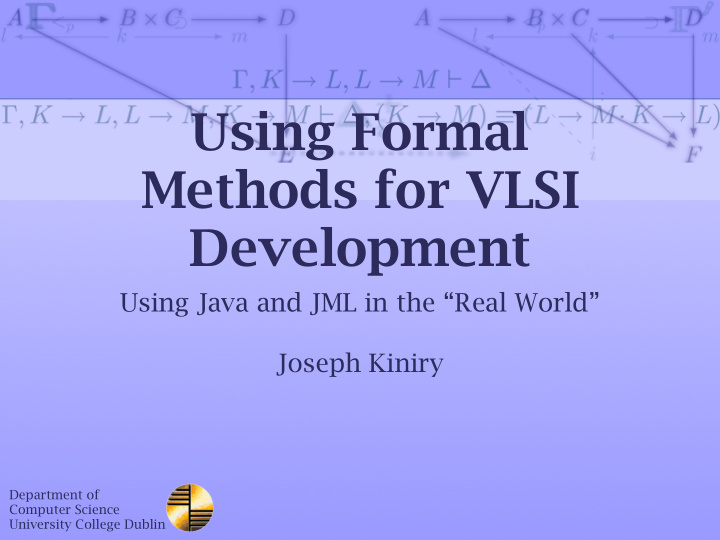



Using Formal Methods for VLSI Development Using Java and JML in the “Real World” Joseph Kiniry Department of Computer Science University College Dublin
Asynchronous VLSI What is AVLSI? delay insensitive circuits power invariant design scalability process invariant Manchester vs. Caltech Department of Computer Science 2 University College Dublin
Typical VLSI Process high level specification (e.g., VHDL) low-level specification (e.g., Verilog) automated layout 99% commercial tools Department of Computer Science 3 University College Dublin
An AVLSI Design Process multiple specification levels multiple Java realizations CSP (Concurrent Sequential Processes) production rules Verilog automated and manual layout cosimulation for behavioral equivalence testing for checking formal refinement Department of Computer Science 4 University College Dublin
Unit Testing and Cosimulation must test at multiple granularities cell, unit, CPU test with and without an operating system minimal test OS and Linux test at all refinement levels a test written in Java does not necessarily conform to any test written for CSP Department of Computer Science 5 University College Dublin
Challenges performance Your try simulating a processor in Java! scalability massive memory and thread use robustness if simulation takes five days and your simulator crashes after four… correctness! you cannot patch a fabricated chip Department of Computer Science 6 University College Dublin
Observations on Arrival major misuse of concurrency data structure abuse aimless optimization untracked requirements changes no documentation process Department of Computer Science 7 University College Dublin
Recommendations and Response refine the software engineering process particularly wrt docs and specs use commercial tools where appropriate analysis with JProbe and jProfiler revision control with Perforce simulation with Cadence Department of Computer Science 8 University College Dublin
Recommendations and Response (2) Open Source tools where appropriate custom code coverage with Gretel metrics with JavaNCSS and SlocCount documentation with SGML and LaTeX specification with JML build system with Ant Department of Computer Science 9 University College Dublin
Convincing the Boss and Coworkers lead by example gather hard data and present it well use the “soft sell” suggest solutions and solve other people’s problems in intriguing ways convince key personnel key developers, managers, executives, and board members Department of Computer Science 10 University College Dublin
Problems and Resistance speed and memory issues jmlc and jmlrac non-linear system compilation impact configurability of compilation and testing unit of configuration is the class would prefer Ei ff el approach with configurability by assertion type lack of support from above long-term prospects for use low Department of Computer Science 11 University College Dublin
Positive Results performance typical: 10 minute change for 10% atypical: 1 man-month for 1000% memory use garbage collection abuse iterators, events, and string bu ff ers operating system VM abuse overall memory size Department of Computer Science 12 University College Dublin
Positive Results (2) configuration management plain text configuration files properties, bundles, and custom system monitoring domain-specific run-time monitoring framework process changes trading JML for English docs Department of Computer Science 13 University College Dublin
Recommend
More recommend